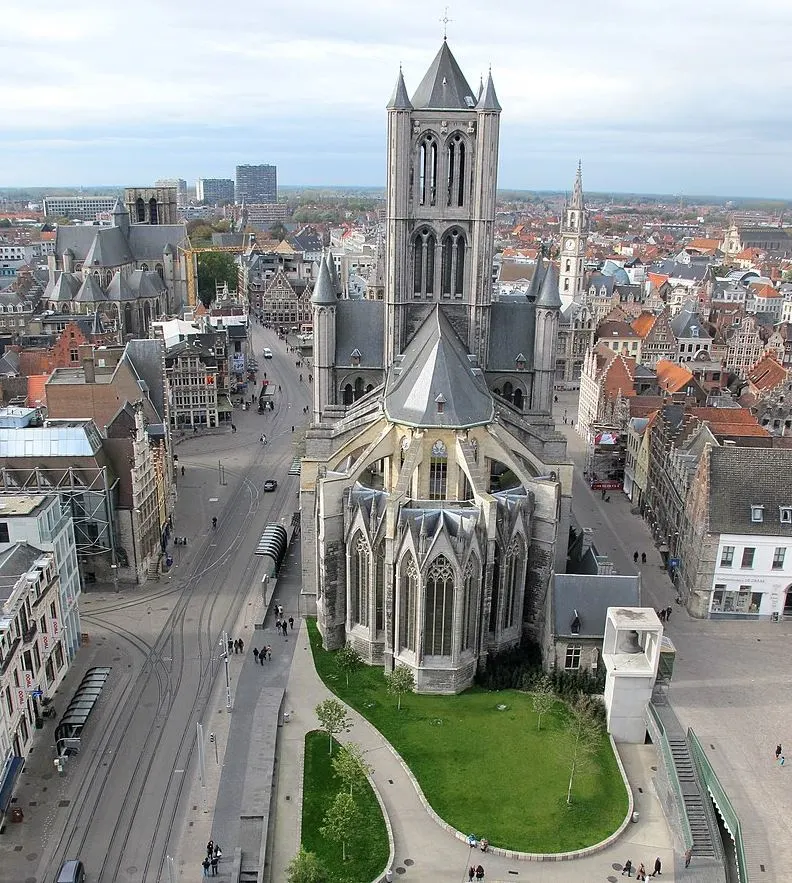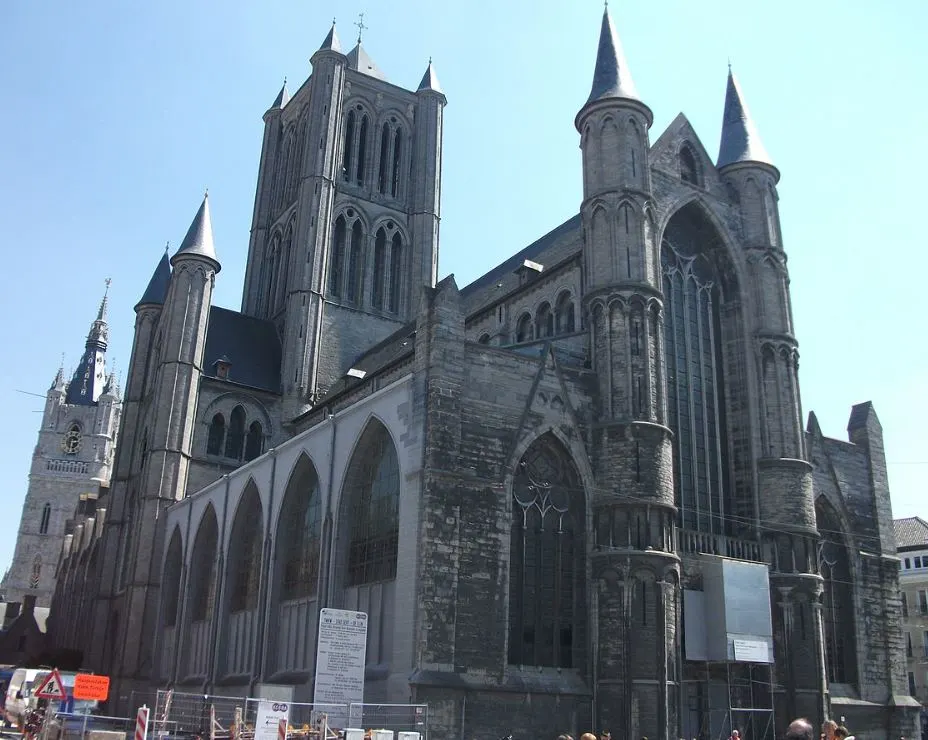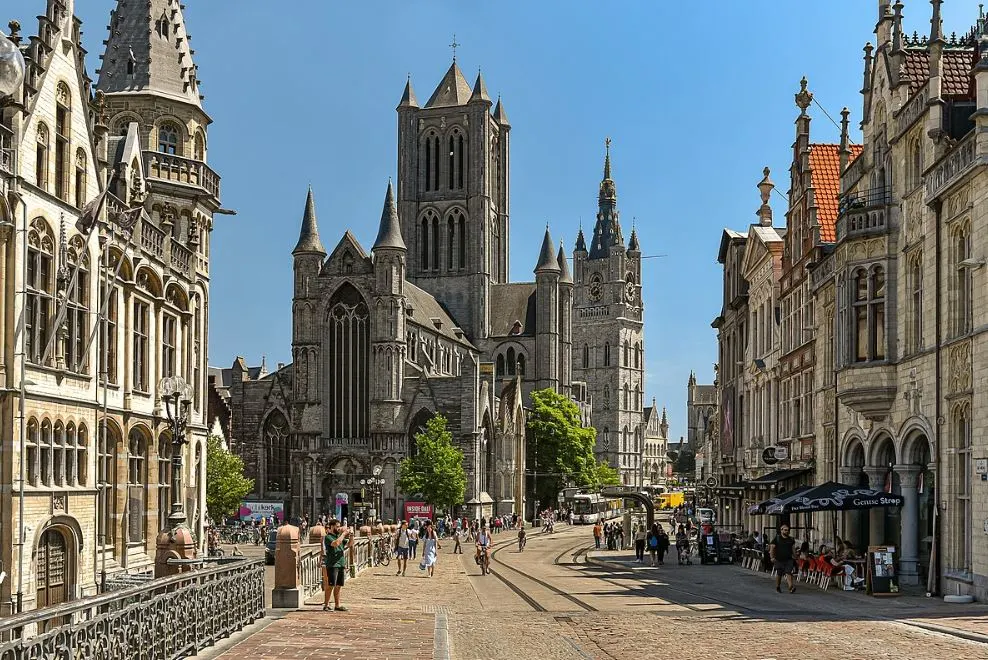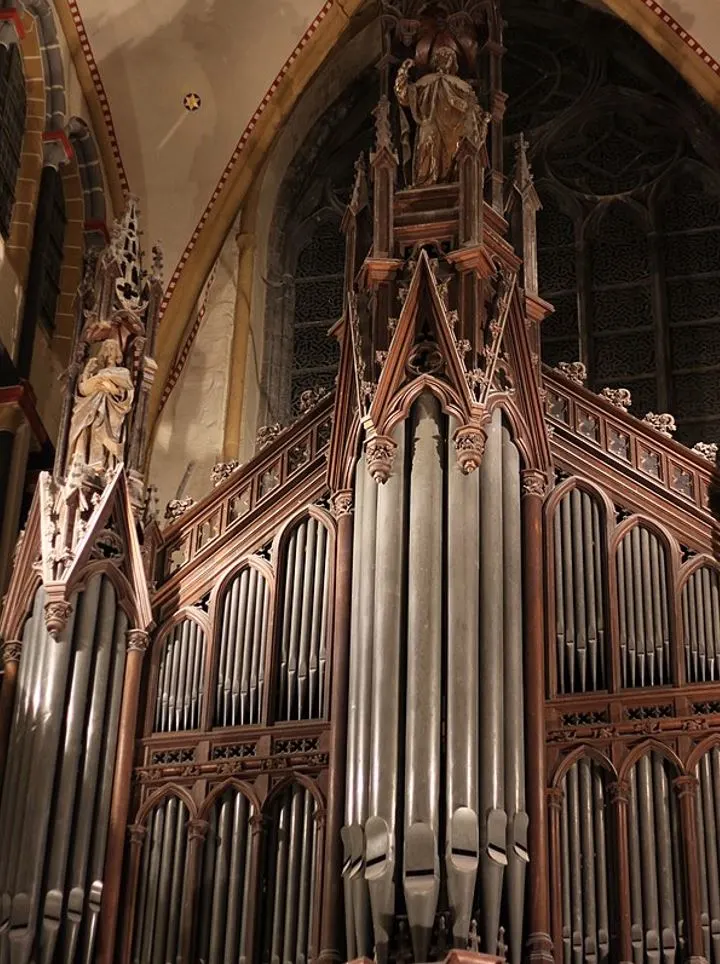It’s no exaggeration when I say that the city of Ghent in modern-day Belgium had the most impressive skyline in the world during the Middle Ages.
That’s because 3 major buildings in Ghent are lined up in the city center, Saint Bavo’s Cathedral, the Belfry of Ghent, and the fascinating church you’ll discover in this article.
Constructed in a remarkable variant of Gothic architecture, this church has a history of almost 800 years.
In this article, you’ll discover some of the most interesting facts about Saint-Nicholas Church in Ghent, one of the city’s most stunning landmarks.
1. It’s the westernmost of the three major structures in the center of Ghent
The city of Ghent is dominated by three tall medieval buildings, which is quite remarkable. That’s why the city is sometimes referred to as the “Manhattan of the Middle Ages.”
Saint-Nicholas Church is the westernmost of these three buildings and is located just one block east of the banks of the Leie River.
The popular Korenmarkt square is located between the river and the church and as you surely expected, this is one of the most popular touristic spots in the city.
Especially the view from this square with the three historic towers in the background is one of the most fascinating medieval pictures in Europe.

2. It was constructed on the location of a former Romanesque church
The massive church we can admire today was constructed in the 13th century but this wasn’t the first building in this location.

The city started to grow in the 11th century as the capital city of the County of Flanders and many buildings were constructed during this period.
This includes, for example, the famous Gravensteen Castle which served as the residence of the Counts of Flanders for hundreds of years.
A church already stood here in the 11th century and this building was constructed in the Romanesque architectural style.
The first building was destroyed by fire in 1120 and the second was demolished in 1200 to make way for a new church.

3. Two local abbeys commissioned a church around the same time
The construction of Saint Nicholas Church was commissioned by Saint Peter’s Abbey, one of the two major abbeys in the city during the Middle Ages.
What’s remarkable is that the other abbey, Saint Bavo’s Abbey, also commissioned a massive church around the same time known as Saint Michael’s Church.
This is actually the fourth major building in a straight line in the center of Ghent, but it’s located across the Leie River.
It doesn’t feature massive towers but is certainly equally large in size. The original church was rebuilt and completed in the 15th century in the late-Gothic style.

4. It was completed in the 13th century in a local early Gothic architectural style
The architectural style of Saint-Nicholas Church in Ghent is known as Scheldt Gothic. It can be defined as a transition between Romanesque and Gothic architecture.
This means that the building still incorporates a very robust design with sturdy towers, but also incorporates Gothic elements such as pointy windows and slender towers with spires at the corners.
Another distinctive feature of this style is that these buildings were constructed with blue-grey stone quarried in the region of Tournai, a city in the Hainaut province of Belgium.
These could easily be transported via the Scheldt River which also flows through the city of Tournai.

5. There’s something special about the central tower of Saint-Nicholas Church in Ghent
The central tower of the church is located above the transept of the church and stands 76 meters (239.34 feet) tall. It originally held the bells that were moved to the Belfry of Ghent.
The most remarkable feature about this tower apart from its height and location is that it serves as a so-called “lantern tower.”
Because of the fact that it’s open, it allows natural light to enter the church which makes the interior a lot brighter than that of most other churches.

6. The local guilds of the city added chapels in the 14th and 15th centuries
So why is it called “Saint Nicholas Church” anyway?
The church was dedicated to Saint Nicholas (270-342), a 4th-century bishop of Myra in modern-day Turkey who was the patron saint of the local merchants.
The church is located right next to the Korenmarkt or “Wheat Market” and many guilds were established here. These guilds also constructed multiple chapels to expand the church in the 14th and 15th centuries.
By the 13th century, the city of Ghent was the largest city in Europe above the Alps and this means this place was bustling with activity during this period in history.

7. The most notable treasure inside the church is a 19th-century organ
You can admire the Ghent Altarpiece at Saint Bavo’s Cathedral, but it’s definitely worthwhile to enter Saint Nicholas Church in Ghent as well.
Inside, you can find 18th-century sculptures, Baroque paintings, and most importantly, an organ constructed by French organ builder Aristide Cavaillé-Coll (1811-1899).
He was the most renowned organ builder of the 19th century and produced dozens of amazing organs that are located in churches all around the world today.

8. It was in urgent need of restoration and this happened in the 20th century
Starting in the 16th century, the church was mainly neglected by the guilds and local authorities. It wasn’t until the 20th century that some efforts to restore the church were undertaken.
Both projects between 1912 and 1913 and 1939 and 1943 were disrupted by the World Wars and resumed in the 1960s.
The massive endeavor to restore this amazing medieval monument was only completed in 1992.
It’s fair to conclude that this was a successful project, especially considering the state that the church was in at the start of the 20th century.

